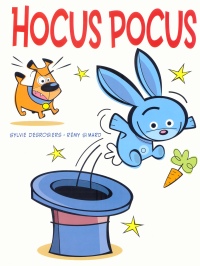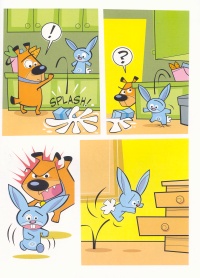| ________________
CM . . . . Volume XVIII Number 24 . . . . February 24, 2012
Hocus Pocus is a blue rabbit who lives in a magician’s hat and has a huge appetite for carrots. Unfortunately, Dog is a grumpy canine who dislikes Hocus and who has made it his mission to keep the rabbit from eating the magician’s carrots. Of course, when Hocus spies the magician’s newly purchased sweet fat carrots on the kitchen counter, he must use all his wits to outmaneuver Dog’s guarding talents.
Speaking of visuals, Rémy Simard’s computer rendered animals are very colourful, iconic and drawn with a wide range of facial and body gestures that clearly display emotion and intention. Most youngsters will know when Hocus Pocus is scared, Dog is angry, and either is confused or surprised. I particularly like how Simard used red backgrounds to highlight conflict and how he varied the number of comic-like frames on each page to add variety and unpredictability to the story. The multiple clashes and crisis in the book keep the story line moving along briskly and maintain the reader’s interest. Just when you think Hocus has bested Dog, Dog surprises you and pulls a fast one on Hocus, keeping him from reaching the carrots. Similarly, just when you think Hocus is the cute and cuddly rabbit who deserves a break from the vicious canine, Hocus sets up Dog for several surprises that has you questioning whether Dog shouldn’t deserve the break. In the end, one of them gets locked outside, and you know that this struggle deserves a follow up book. Throughout this book, I couldn’t stop thinking of Dog and Hocus as paralleling classic physical actor duos like Laurel and Hardy and Abbott and Costello. In the true vein of these actors, Dog and Hocus rattle the reader through a rapid succession of slapstick events that are so surprising and unpredictable that the reader can’t wait to turn the page and see what outrageous events will unfold next. The one criticism some would say about the book is that it is this very rapid succession of visual events that might confuse and discombobulate some readers (especially those not accustomed to multiple frames per page) to the point of frustration. Hocus Pocus is a delightfully hilarious read that will have young readers giggling, sniggering, and howling while cheering Dog on, cheering Hocus on, and begging the artists for a sequel. Recommended. Keith McPherson has been an elementary teacher and teacher-librarian in BC since 1984, and he is currently a lecturer for the Department of Language and Literacy Education at the University of British Columbia in Vancouver, BC.
To comment
on this title or this review, send mail to cm@umanitoba.ca.
Copyright © the Manitoba Library Association. Reproduction for personal
use is permitted only if this copyright notice is maintained. Any
other reproduction is prohibited without permission.
NEXT REVIEW |
TABLE OF CONTENTS FOR THIS ISSUE
- February 24, 2012.
AUTHORS |
TITLES |
MEDIA REVIEWS |
PROFILES |
BACK ISSUES |
SEARCH |
CMARCHIVE |
HOME |

 Hocus Pocus is a picture book with very few words. Not quite a true wordless book, it does use words sparingly to indicate animal sounds, such as the ‘grrrr’ of Dog’s growl, and non verbal environmental sounds, such as ‘scratch scratch’ sound of the magician’s fingers scratching Dog’s head. Although these words do add a sound component to the visuals, and they further the story’s visual humour, young readers who cannot understand these print symbols will find the visuals provide strong comprehensible input and thus a good understanding of the story line.
Hocus Pocus is a picture book with very few words. Not quite a true wordless book, it does use words sparingly to indicate animal sounds, such as the ‘grrrr’ of Dog’s growl, and non verbal environmental sounds, such as ‘scratch scratch’ sound of the magician’s fingers scratching Dog’s head. Although these words do add a sound component to the visuals, and they further the story’s visual humour, young readers who cannot understand these print symbols will find the visuals provide strong comprehensible input and thus a good understanding of the story line.